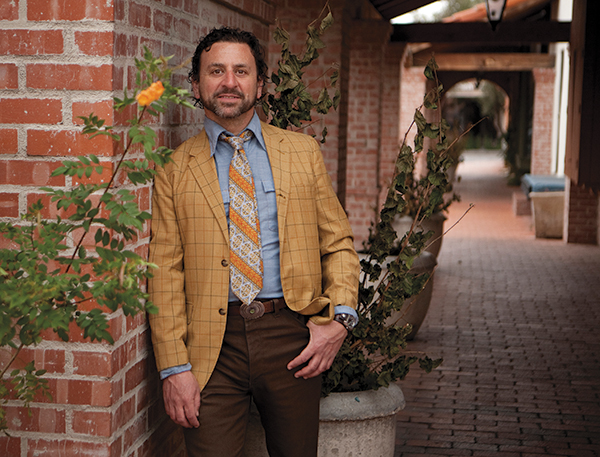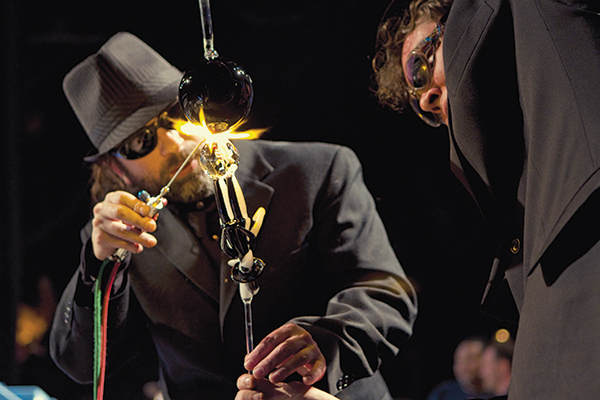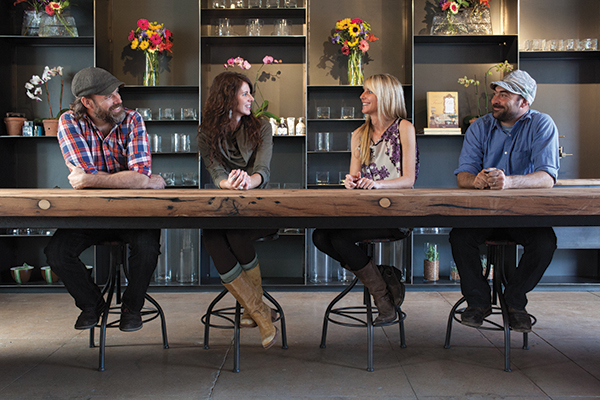Falora Opens
 Ari Shapiro is a busy man. Despite his successes with Sparkroot and Xoom, Shapiro dreamt of owning a “cozy, hole-in-a-beaut-wall authentic pizza joint.” When a space opened up in the Broadway Village, a historic Josias Joesler shopping center with tile floors and arched windows, Shapiro saw the perfect space. “I had to move my vision up a few years,” he joked. And now, Falora is set to open March 2nd.
Ari Shapiro is a busy man. Despite his successes with Sparkroot and Xoom, Shapiro dreamt of owning a “cozy, hole-in-a-beaut-wall authentic pizza joint.” When a space opened up in the Broadway Village, a historic Josias Joesler shopping center with tile floors and arched windows, Shapiro saw the perfect space. “I had to move my vision up a few years,” he joked. And now, Falora is set to open March 2nd.
“We knew the space had tremendous potential, but after years of multiple remodels, it needed to be stripped to its core to reveal the rustic beauty, which we are letting speak for itself.” The “we” in this instance is Shapiro’s partnership with Repp Design, who worked with him to create a specific atmosphere at Sparkroot. “They have a wonderful ability to coalesce my vision into a fully-formed space,” he said. And this project’s goal can be described with three words: rustic, historic, and authentic. “I adore the historic architecture of Josias Joesler, who built the entire shopping center in 1939. We want people to feel like they’re eating in an authentic neighborhood pizzeria. Most of the seating is at one long community farm table. The lighting will be dim, music from a vintage stereo. We want folks to hear the crackling oven, get to know one another, truly enjoy the entire experience,” he elaborates. “I think a place can be bustling and comforting at the same time; my favorites in other cities always capture that essence.”
Shapiro’s vision is partly inspired by his trips to Italy, where a sense of community is paired with simple, inspired food. In a nod to the operation of many Italian restaurants, Falora will be a different kind of place in the morning, where homemade breads, jams, and locally roasted coffee from Caffe Luce will grace the table. In the evenings, it will be laden with some ingredients imported from Italy, and others farmed locally. Shapiro provided me with a list that sounds like geographical poetry: “San Marzano tomatoes which grow on volcanic plains near Mount Vesuvius; Mozzarella di Bufala from Italian water buffalo; and Caputo flour, a finely ground flour that has a lower gluten content” will all join local produce from Sleeping Frog Farms in Cochise for seasonal pizzas and salads. “We focus on balancing tradition with a sharply creative angle,” Shapiro wrote, adding that an influence from the “diverse phenom” of New York pizza will make its way onto the menu. After all, Shapiro says, “I am a native New Yorker, so I have a tremendous appreciation and love of pizza, growing up with giant slices from Famous Ray’s. New York truly took the Naples invention to the next level.” The drink selection will be similarly matched, with Italian wines and European beers (“obviously Peroni,” Shapiro added) alongside noteworthy Tucson brews. And for dessert: homemade panna cotta, a magical simmered cream custard traditional to northern Italy.
The name, Falora, is a lyrical invented word meant to sound a little Italian, a little like “flora”, and a little like “flour,” evoking an old world pizzeria atmosphere. The Stefano Ferrera wood fired oven certainly contributes to the character. Hand-built by a third generation maker in Naples, the brick oven is fueled entirely by wood – most use natural gas to supplement – and cranks up to 800 degrees. This oven is the centerpiece that will make Falora’s simple and authentic Napoli pizza possible. If you read Eat, Pray, Love and remember the scene where the author and her friend go crazy over their simple cheese pizzas in Naples, pizzas with crust that’s magically thin and chewy, topped with a sliding layer of buffalo mozzarella and a sprig of basil – if you remember their happy delirium, then you’ll be as expectant for Falora as I am.




 For Katie Treat, owner of Posh Petals, setting up her new shop in the historic Tophy Building has brought her into the fold of 4th Avenue. Posh Petals specializes in custom flowers for events, so the retail space is a bit of a blank canvas. It’s a comfortable shop that she’s filled with funky antiques, artful glass vases, flower boxes, pots, and votives.
For Katie Treat, owner of Posh Petals, setting up her new shop in the historic Tophy Building has brought her into the fold of 4th Avenue. Posh Petals specializes in custom flowers for events, so the retail space is a bit of a blank canvas. It’s a comfortable shop that she’s filled with funky antiques, artful glass vases, flower boxes, pots, and votives.

 For nearly 40 years, the Tanque Verde Swap Meet has been a place people can come, peruse, and leave with something fabulous and unexpected. Passing by the space during the week, it looks like a wide dusty lot with a few small trees; but Thursday through Sunday the lot on South Palo Verde Avenue comes alive with people browsing and hawking just about anything that can fit into over 800 booths. On the first ever “Super Sunday,” premiering October 21, patrons will see even more of the fabulous and unexpected.
For nearly 40 years, the Tanque Verde Swap Meet has been a place people can come, peruse, and leave with something fabulous and unexpected. Passing by the space during the week, it looks like a wide dusty lot with a few small trees; but Thursday through Sunday the lot on South Palo Verde Avenue comes alive with people browsing and hawking just about anything that can fit into over 800 booths. On the first ever “Super Sunday,” premiering October 21, patrons will see even more of the fabulous and unexpected. “I see the Screening Room as this gem that not everyone knows about,” says Karen Greene, one of the founders of Mind Our Own Businesses, a community group focused on getting people downtown and on 4th Avenue while the street construction fences are up. Her latest project: getting folks to come see The Avenue, a documentary on Tucson’s 4th Avenue and its attendant thriving, non-corporate arts district. The film is showing at the Screening Room on September 15th. The Avenue showed twice at the Arizona International Film Festival to sold-out crowds, and was awarded Best of Arizona in the show.
“I see the Screening Room as this gem that not everyone knows about,” says Karen Greene, one of the founders of Mind Our Own Businesses, a community group focused on getting people downtown and on 4th Avenue while the street construction fences are up. Her latest project: getting folks to come see The Avenue, a documentary on Tucson’s 4th Avenue and its attendant thriving, non-corporate arts district. The film is showing at the Screening Room on September 15th. The Avenue showed twice at the Arizona International Film Festival to sold-out crowds, and was awarded Best of Arizona in the show. An ‘All-Souls’-inspired Puppets Amongus show goes to Kazakhstan
An ‘All-Souls’-inspired Puppets Amongus show goes to Kazakhstan Local artist Chris Leon’s paintings are bright graphic portraits, some in a pinwheel of colors, others in high-contrast monochrome. They’re focused, with bold edges, in the highly relatable style of graphic novels. Leon also gives art lessons to kids aged 5-15, and when he began working with a three-year-old autistic child, something clicked. “I was blown away at how amazing these kids are and how they function,” Leon said. “The thing that really impressed me about working with this autistic kid was how close artists are to autistic people. When I get focused on something I zone in, I want to be left alone; I’m looking at this kid and he’s concentrating on spelling ‘xenophobe’ and he’s only three years old. It’s very, very cool.” Leon wanted to do something, and when he related his experience to fellow artist Zombilly Ray (who himself has an autistic child) the pair decided to put on a benefit for autism. “It started off as a little brainchild and it’s kind of blown up,” Leon says of the event that now involves dozens of artists, musicians and vendors.
Local artist Chris Leon’s paintings are bright graphic portraits, some in a pinwheel of colors, others in high-contrast monochrome. They’re focused, with bold edges, in the highly relatable style of graphic novels. Leon also gives art lessons to kids aged 5-15, and when he began working with a three-year-old autistic child, something clicked. “I was blown away at how amazing these kids are and how they function,” Leon said. “The thing that really impressed me about working with this autistic kid was how close artists are to autistic people. When I get focused on something I zone in, I want to be left alone; I’m looking at this kid and he’s concentrating on spelling ‘xenophobe’ and he’s only three years old. It’s very, very cool.” Leon wanted to do something, and when he related his experience to fellow artist Zombilly Ray (who himself has an autistic child) the pair decided to put on a benefit for autism. “It started off as a little brainchild and it’s kind of blown up,” Leon says of the event that now involves dozens of artists, musicians and vendors.



Also find us on...